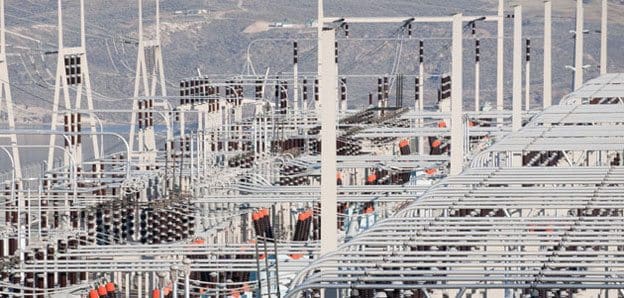Function of Substations
Transmission and Distribution Systems
In large, modern AC power systems, the transmission and distribution systems function to deliver bulk power from generating sources to users at the load centers.

Transmission systems generally include generation switchyards, interconnecting transmission lines, autotransformers, switching stations, and step-down transformers. Distribution systems include primary distribution lines or networks, transformer banks, and secondary lines or networks, all of which serve the load area.
Design Objectives
As an integral part of the transmission or distribution systems, the substation or switching station functions as a connection and switching point for generation sources, transmission or subtransmission lines, distribution feeders, and step-up and step-down transformers.
The design objective for the substation is to provide as high a level of reliability and flexibility as possible while satisfying system requirements and minimizing total investment costs.
Voltage Levels
The selection of optimal system voltage levels depends on the load to be served and the distance between the generation source and the load.
Many large power plants are located great distances from the load centers to address energy sources or fuel supplies, cooling methods, site costs and availability, and environmental concerns. For these reasons, the use of transmission voltages as high as 765 kV has occurred. Transmission system substations that provide bulk power operate at voltages from 69 to 765 kV.
Even higher voltages which include 1100 and 1500 kV have been considered. These are referred to as ultra high voltage or UHV class. Distribution system substations operate at secondary voltage levels from 4 to 69 kV.
Design Considerations
Many factors influence the selection of the proper type of substation for a given application. This selection depends on such factors as voltage level, load capacity, environmental considerations, site space limitations, and transmission-line right-of-way requirements.
While also considering the cost of equipment, labor, and land, every effort must be made to select a substation type that will satisfy all requirements at minimum costs. The major substation costs are reflected in the number of power transformers, circuit breakers, and disconnecting switches and their associated structures and foundations.
Therefore, the bus layout and switching arrangement selected will determine the number of the devices that are required and in turn the overall cost.
The choice of insulation levels and coordination practices also affects cost, especially at EHV. A drop of one level in basic insulation level (BIL) can reduce the cost of major electrical equipment by thousands of dollars. A careful analysis of alternative switching schemes is essential and can result in considerable savings by choosing the minimum equipment necessary to satisfy system requirements.
A number of factors must be considered in the selection of bus layouts and switching arrangements for a substation to meet system and station requirements.
The physical orientation of the transmission-line routes often dictates the substation’s location, orientation, and bus arrangement. This requires that the selected site allow for a convenient arrangement of the lines to be accomplished.
For reliability, the substation design should reduce the probability of a total substation outage caused by faults or equipment failure and should permit rapid restoration of service after a fault or failure occurs. The layout also should consider how future additions and extensions can be accomplished without interrupting service.
Bus Schemes
The substation design or scheme selected determines the electrical and physical arrangement of the switching equipment. Different bus schemes can be selected as emphasis is shifted between the factors of safety, reliability, economy, and simplicity dictated by the function and importance of the substation.
The substation bus schemes used most often are:
- Single bus
- Main and transfer bus
- Double bus, single breaker
- Double bus, double breaker
- Ring bus
- Breaker and a half
Some of these schemes may be modified by the addition of bus-tie breakers, bus sectionalizing devices, breaker bypass facilities, and extra transfer buses.
SOURCE: W. Dietzman, Philip Bolin – Substations











Dear Edvard, i am not an electrical engineer but i found out your article useful and simple to get the general idea. would like to say thanks for your great efforts.
Dear Sir,
Pls send the AIS substation design and calculation